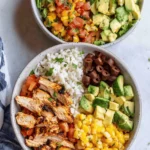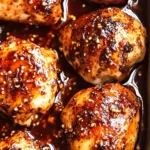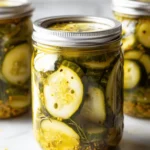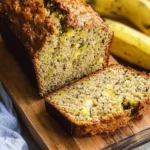These tender, slow-cooked pork ribs are glazed with a luscious smoky barbecue sauce, creating the perfect balance of savory and sweet. The caramelized sauce adds an irresistible smoky flavor that complements the richness of the meat.
The beauty of this dish lies in its simplicity. Whether served for a casual dinner or at a summer BBQ, the smoky aroma and rich taste will delight your guests. Pair these ribs with your favorite sides for a complete meal, and don’t forget the extra barbecue sauce for dipping!
Full Recipe:
-
2 racks pork ribs
-
1 cup barbecue sauce
-
1 tablespoon smoked paprika
-
1 tablespoon brown sugar
-
1 tablespoon garlic powder
-
1 tablespoon onion powder
-
1 tablespoon salt
-
1 tablespoon black pepper
-
1 teaspoon chili powder
-
1 teaspoon cayenne pepper (optional)
-
1 tablespoon olive oil
-
1 tablespoon apple cider vinegar
Directions:
-
Preheat your oven to 300°F (150°C).
-
Remove the silver skin from the ribs by gently pulling it off the back of the ribs.
-
In a small bowl, mix together smoked paprika, brown sugar, garlic powder, onion powder, salt, black pepper, chili powder, and cayenne pepper to make the dry rub.
-
Rub the seasoning mixture all over both sides of the ribs.
-
Heat olive oil in a large skillet over medium-high heat. Sear the ribs on both sides until golden brown (about 2-3 minutes per side).
-
Transfer the ribs to a baking dish and cover with aluminum foil.
-
Bake the ribs in the preheated oven for 2.5-3 hours, or until they are tender and cooked through.
-
While the ribs are baking, combine barbecue sauce and apple cider vinegar in a small bowl.
-
Once the ribs are done, remove them from the oven and brush with the smoky barbecue sauce.
-
Return the ribs to the oven for an additional 10 minutes to caramelize the sauce.
-
Serve hot with extra barbecue sauce on the side.
Prep Time: 10 minutes | Cooking Time: 3 hours | Total Time: 3 hours 10 minutes
Kcal: 320 kcal per serving | Servings: 4 servings
History and Origin
Barbecued pork ribs are a beloved dish, particularly in American cuisine, and have become a staple in Southern cooking. The dish has deep roots in the history of barbecue itself, which can be traced back to indigenous cooking methods, where meats were slow-cooked over open flames. Over time, this cooking method evolved, with the introduction of different marinades, rubs, and sauces to enhance the flavor of meats.
In the U.S., barbecue pork ribs became particularly popular in the South, where the style of cooking meats over low heat for long periods is a tradition that dates back centuries. Different regions of the South, such as Texas, Kansas City, and Memphis, each have their own take on barbecue ribs. Memphis, for instance, is known for its dry rub style, while Kansas City favors a sweeter, tangier sauce.
The smoky barbecue sauce that coats these ribs is a hallmark of the dish, blending ingredients like smoked paprika, garlic, and brown sugar to create a perfect balance of sweet and smoky flavors. The ribs themselves have a strong connection to classic Southern BBQ traditions, but their appeal has spread far beyond the American South, becoming popular at cookouts and restaurants worldwide.
Variations and Adaptations
While the core of the recipe remains the same—tender pork ribs smothered in a smoky barbecue sauce—there are numerous variations and regional adaptations of this dish, especially when it comes to the sauce.
-
Memphis-Style Ribs: Memphis-style ribs typically feature a dry rub that is liberally applied to the meat before cooking. The rub, which includes a combination of salt, pepper, paprika, and other spices, allows the flavor of the meat to shine through, with the sauce often served on the side. For those who prefer a more robust, spice-forward flavor, Memphis-style ribs are the way to go.
-
Kansas City-Style Ribs: Kansas City-style barbecue is famous for its sweet, tangy sauce. A ketchup-based sauce with brown sugar, molasses, and vinegar forms the base, and the ribs are typically coated in the sauce and baked or grilled until caramelized. This variety brings a delightful sweetness that contrasts beautifully with the smoky pork.
-
Texas-Style Ribs: Texas barbecue is known for its bold, savory flavors. Texas-style ribs are often cooked using the “low and slow” method over indirect heat, imparting a rich, smoky flavor to the meat. The barbecue sauce tends to be more straightforward, focusing on the smoky flavor with less emphasis on sweetness, allowing the meat’s natural flavors to shine.
-
Asian-Inspired Ribs: For those looking to explore international flavors, an Asian-inspired barbecue sauce can add a unique twist to pork ribs. A blend of soy sauce, hoisin sauce, ginger, garlic, and brown sugar creates a savory-sweet sauce with an Asian flair, which can be slathered onto the ribs for a completely different taste experience.
-
Spicy Variants: Some barbecue enthusiasts love to turn up the heat with spicy ingredients like cayenne pepper, chili flakes, or hot sauce in the rub or barbecue sauce. If you enjoy a little kick in your ribs, you can easily increase the spice level to suit your taste.
Nutritional Information
Pork ribs are a flavorful source of protein, but like many meat-based dishes, they are also relatively high in fat. The exact nutritional breakdown can vary depending on the cut of pork and the specific sauce used, but here’s a general idea of what you can expect:
-
Calories: A typical serving of pork ribs (around 3-4 ribs) contains approximately 320-350 calories. This can vary depending on how much sauce is used and the fat content in the ribs.
-
Protein: Pork ribs are a great source of protein, with around 20-25 grams of protein per serving.
-
Fat: Depending on the cut of ribs, fat content can vary widely. For example, baby back ribs may have slightly less fat than spare ribs, but you can still expect around 20-25 grams of fat per serving. Much of this fat is healthy monounsaturated fat, but it’s still important to enjoy the dish in moderation.
-
Carbohydrates: Barbecue sauce adds a bit of sugar, making the carbohydrate content around 10-15 grams per serving. This includes both natural sugars from ingredients like brown sugar and any added sweeteners in the sauce.
-
Micronutrients: Pork ribs also offer some micronutrients, including iron, zinc, and B vitamins like niacin and vitamin B12, which are essential for energy production and maintaining healthy red blood cells.
For those following specific diets (e.g., keto or low-carb), the sugar in the barbecue sauce can be adjusted by using sugar-free or reduced-sugar versions, or even opting for a dry rub instead.
Serving Suggestions and Pairings
Pork ribs with smoky barbecue sauce can be served in a variety of ways to complement their rich, savory flavors. Here are some creative ideas for sides and drink pairings:
-
Classic Sides: You can never go wrong with traditional sides like coleslaw, cornbread, or potato salad. These options provide a refreshing crunch and balance out the richness of the ribs.
-
Grilled Vegetables: For a healthier, lighter pairing, consider serving your ribs with grilled vegetables such as corn on the cob, bell peppers, or asparagus. These bring a smoky flavor to the meal without overshadowing the star of the show.
-
Macaroni and Cheese: The creamy, cheesy goodness of macaroni and cheese pairs beautifully with tender, smoky ribs, adding a comforting layer to the meal.
-
Roasted Potatoes: Crispy roasted potatoes, whether seasoned with garlic, rosemary, or simply olive oil and salt, make for an excellent accompaniment.
-
Beverages: To wash it all down, you could pair your ribs with a cold beer, such as a lager or pale ale, which provides a crisp contrast to the richness of the meat. For wine lovers, a full-bodied red wine like Zinfandel or Shiraz works well with the smoky and spicy flavors. If you’re looking for something non-alcoholic, iced tea or lemonade are classic BBQ drink options.
Tips and Tricks for Success
-
Patience is Key: The key to perfect pork ribs is slow cooking. Whether you’re using a grill, smoker, or oven, low and slow heat allows the fat to render and the meat to become tender and juicy. Don’t rush the process.
-
Use a Meat Thermometer: While cooking, check the internal temperature of the meat to ensure it’s cooked through. For ribs, the internal temperature should reach around 190°F (88°C) for ultimate tenderness.
-
Rest the Ribs: After baking or grilling, let your ribs rest for a few minutes before cutting into them. This helps retain their juices, ensuring each bite is succulent.
-
Homemade BBQ Sauce: If you have the time, homemade barbecue sauce can take your dish to the next level. A simple mix of ketchup, brown sugar, vinegar, and spices will enhance the flavor and allow you to adjust the sweetness and smokiness to your liking.
Potential Health Benefits
Though pork ribs are not typically thought of as a health food, they do have some benefits when consumed in moderation. Pork is a good source of high-quality protein, which is essential for muscle building and tissue repair. It also contains important vitamins and minerals, including iron and zinc, which support immune function and help prevent anemia.
However, it’s worth noting that ribs are high in fat, and the barbecue sauce can add a considerable amount of sugar. If you’re looking to reduce fat intake or avoid excess sugar, consider making a few adjustments, like using leaner cuts of pork or a sugar-free barbecue sauce.
Conclusion
Pork ribs with smoky barbecue sauce are the ultimate comfort food—tender, juicy, and packed with flavor. Whether you’re cooking for a special occasion or just looking for a delicious meal to share with friends and family, this recipe will surely impress. With its roots in Southern barbecue traditions, the smoky, sweet ribs offer a taste of history while being adaptable to many variations. Perfect for any occasion, these ribs bring people together around a plate of mouth-watering goodness. Don’t hesitate to try this recipe and savor the smoky flavors in your own home!





